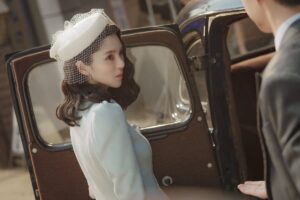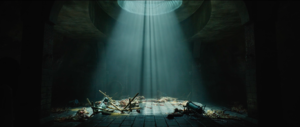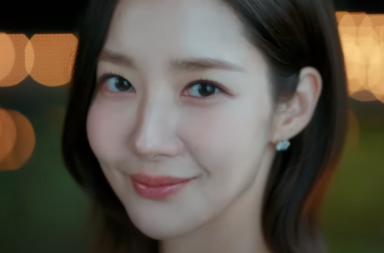
It’s pretty clear, as we reach the end of 2023, that Netflix is happily putting a lot of its eggs into South Korea’s basket. It has programmed some of its biggest K-drama milestones at the end-of-year period for the past few years now—Sweet Home came out in December 2020, The Silent Sea in December 2021 and The Glory in December 2022—and this year is no different. In their latest effort, Gyeongseong Creature, the studio throws glossy production, a star-studded cast, and an array of genres at this monster tale, set in the final months of imperial Japanese rule in Korea.
It’s a heady mix to see off the year, and a slightly unwieldy one for the most part. The cast list alone proves Netflix’s confidence even in creating a story with this many conflicting tones. Itaewon Class’s Park Seo-joon, Nevertheless’s Han So-hee and Squid Game’s Wi Ha-joon are the faces of this show, with the Fantastic Beasts franchise’s Claudia Kim, Reborn Rich’s Jo Han-chul and many more filling out the supporting cast. They take on a story that is ostensibly horror, though there are enough diversions from this mode of storytelling to make one mistake it for a drama or a romance. An unevenly told narrative, Gyeongseong Creature nonetheless builds to a suspenseful crescendo at the close of its part one finale (which is, also rather unevenly, episode seven of ten).
The backdrop of the drama’s horror is the often-utilised period of Japan-occupied Korea, which we see here six months prior to its downfall in 1945. The opening scene of the show throws us right into the heart of a dark military laboratory, with a monster on the loose that seems to be destroying all in its path. It’s a thrilling set piece to begin the drama with, and clues the audience in to the centrality of the Japanese military to this story. Gyeongseong sets out its stall immediately as a take on the horrors of Japanese military experimentation, as this Time article examines in more detail. It isn’t subtle, but it is an exhilarating start.
This exploration of the world of colonial-era Korea is deliciously well realised in the set design and costuming of the drama, which is unsurprising, given Netflix’s commitment to spend $2.5 billion over the next four years on Korean content. The colourful shops lining the town’s main streets are almost like a chocolate box, and the grandeur of main character Jang Tae-sang (Park)’s House of Golden Treasure belies its actual function as a pawn shop.
When we initially see these backdrops, they feel fantastical, artificial even. However, when contrasted with the dank, dark underground of the cells in Onseong Hospital, it becomes clear that this initial brightness is not all it seems, much like the initial appearance of a prosperous city underlies the horrors of colonialism lurking beneath.

The costuming too is sumptuous, though here it fails at being as effective in conveying complexity as the set design does. Where the sets become truly dark and ominous, the costuming of the characters never really strays away into anything truly representative of the poverty and desperation of the Korean characters living under Japanese rule. When these characters are existing in their ordinary lives, this is not an issue: it’s even quite exciting to see the 1940s style executed so well in Yoon Chae-ok (Han)’s powder blue dress, Na Young-chun (Ok Ja-yeon)’s red velvet number, or Jang’s many sharp suits.
However, when these costumes need to illustrate a tougher life, or a poorer existence, they fail to be believable enough. This is a problem inherent to a lot of K-dramas—a hesitation to fully let go of beauty—but it sticks out rather glaringly here, especially when the set design is that much more effective. For example, the outfits worn by Yoon and her father (Chul) are meant to indicate that they are travelling refugees from Manchuria, living hand-to-mouth. So where is the dirt? Where are the rips and tears, the worn-down fabric? There seems to be a missed opportunity to really drive the realities of tough colonial life home on an aesthetic level here.
It may seem strange to put so much focus on the outfits that the characters wear, before discussing the narrative itself. But the problem of the slightly-too-neat-and-nice costuming is emblematic of issues within the entire story of Gyeongseong. Considering the darkness and violence of an opening that introduces evil military experiments and man-eating monsters, the mood seems to be set for a story not afraid to pull punches. Therefore, it is an odd tonal shift when, in the first few episodes, it almost seems set up as a romantic drama. This is nowhere more evident than in the relationship established between Jang and Yoon.

Whilst it isn’t novel at all to pair two famous leads in a story romantically, and it is a field in which Park Seo-joon in particular excels, the moments where they first encounter each other feel played for melodrama in a very jarring fashion. For instance, when the two characters fight after Jang catches Yoon following him in a dark alley, there is a (repeatedly referenced) slow-motion shot of her being knocked back, her hat flying off to reveal her beautiful face and hair as it falls around her. It’s such an over-the-top moment as to suggest that what we are watching will actually be romance-focused, perhaps even comic. In combination with Yoon’s far-too-pretty refugee costuming, moments like this—and there are several—almost undermine the intensity of the monster story at the show’s heart.
This is bizarre, as, when it does pivot its focus entirely to the monster created in the Japanese military lab and the twisted methods used to do this, the narrative becomes serious, tense, and even tragic. From the third episode, the characters enter the mysterious military Onseong Hospital, where no Korean is allowed in and no one ever seems to leave, in order to retrieve a woman that police commissioner Ishikawa (Kim Do-hyun) has ordered Jang to find.
This brings the characters into a tense cat and mouse game with the Japanese soldiers, and allows for the full unveiling of the horrors of Japanese experiments to have their maximum impact through our central figures. There are multiple moments of deep poignancy and graphic, bloody violence here, which is all the more effective as the episodes continue, and the whimsical slant of the romance is left behind.

Once this turn towards the more abject horror has been made, the performances kick in to ‘serious mode’ universally, which does allow for a lot more interesting work from our lead actors. Han So-hee shines when she is able to dig deeply into her emotions, though the real power in these Onseong Hospital scenes comes from the menacing yet inscrutable Colonel Kato (Choi Young-joon). As the leader of the military experiments and chief ‘nasty man,’ Choi has fun portraying a classic sadist in combination with a warped Frankenstein obsessed with his monster.
And what of this actual monster, the heart of the drama and the title for the show? Well, like so many of the best monsters in horror, it is amply more terrifying when we barely see it. Hearing thuds, or seeing only tendrils sneak through a cage, creates a truly ominous presence in the show’s earliest moments. It is a shame that the show loses its nerve enough to show us the full monster as early as it does, undercutting further potential for suspense as the show moves forward.
The creature is also a product of CGI, which, again, undermines its full horror potential. It may be unfair to compare it to Netflix’s King of Monsters, Stranger Things, but, when considering that their use of practical effects created beings of real weight and relatable movement, Gyeongseong’s ‘creature’ becomes that much less believable in comparison. This is perhaps less important in this specific story, as here the monster is so much more obviously an embodiment of the horrors of Japanese colonialism and warfare. Maybe they didn’t want the monster to seem real, as long as it seemed threatening. But nonetheless, there is a slight problem of style over (literal) substance.

Gyeongseong Creature is ultimately a show that doesn’t seem confident running with its premise, and the darkness inherent to it, all the time. Starting out slowly and romantically, it isn’t until the later episodes of the series that the narrative shifts fully into the thriller/horror mode needed to justify the storyline. However, once our lead characters directly face the show’s central monster and understand the terror of what the Japanese soldiers are doing, the show becomes more comfortable leaning into its horror elements.
With the last three episodes scheduled to release on the 5th of January 2024, there is still time for Gyeongseong to fully commit to one genre. As much as the romance between Jang and Yoon has not disappeared, its newer sense of seriousness should hopefully steer the show away from returning to its more over-the-top moments. With the thinly-veiled metaphor of the horrific experiments conducted by the Japanese military at stake, in addition to the central storyline involving Korean independence fighters, it seems clear that the path ahead for this Netflix blockbuster has to be dark. If it has the courage to lean in to this horror and leave everything else behind, then the finale of Gyeongseong Creature could rank just as highly as its December prestige show predecessors.


